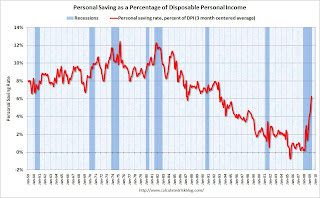by Calculated Risk on 6/26/2009 08:30:00 AM
Friday, June 26, 2009
Personal Income and Outlays Boosted by Stimulus
From the BEA: Personal Income and Outlays, April 2009
Personal income increased $167.1 billion, or 1.4 percent, and disposable personal income (DPI) increased $178.1 billion, or 1.6 percent, in May, according to the Bureau of Economic Analysis. Personal consumption expenditures (PCE) increased $25.1 billion, or 0.3 percent. In April, personal income increased $78.3 billion, or 0.7 percent, DPI increased $140.0 billion, or 1.3 percent, and PCE increased $1.0 billion, or less than 0.1 percent, based on revised estimates. The pattern of changes in personal income and in DPI reflect, in part, the pattern of increased government social benefit payments associated with the American Recovery and Reinvestment Act of 2009.The May numbers were impacted by the American Recovery and Reinvestment Act of 2009. As an example, payments to seniors increased sharply and “Personal Current Transfers,” increased by $165 billion (annual rate). This boosted personal income.
...
Real PCE -- PCE adjusted to remove price changes -- increased 0.2 percent in May, in contrast to a decrease of 0.1 percent in April.
...
Personal saving -- DPI less personal outlays -- was $768.8 billion in May, compared with $608.5 billion in April. Personal saving as a percentage of disposable personal income was 6.9 percent in May, compared with 5.6 percent in April.
This also pushed up the saving rate sharply to the highest rate since Dec 1993 (but this is a temporary boost).
A couple points:
 Click on graph for large image.
Click on graph for large image.This graph shows the saving rate starting in 1959 (using a three month centered average for smoothing) through the April Personal Income report. The saving rate was 6.9% in April. (6.3% with average)
The saving rate was boosted by the stimulus package, but this suggests households are saving substantially more than during the last few years (when the saving rate was close to zero). The saving rate will probably dip - the stimulus boost is unsustainable - but then continue to rise (an aging population usually pushes the saving rate higher) and a rising saving rate will repair household balance sheets, but this will also keep pressure on personal consumption.
The following graph shows real Personal Consumption Expenditures (PCE) through May (2000 dollars). Note that the y-axis doesn't start at zero to better show the change.
 PCE declined sharply in Q3 and Q4 2008, and rebounded slightly in Q1 2009.
PCE declined sharply in Q3 and Q4 2008, and rebounded slightly in Q1 2009.Although PCE increased in May (compared to April), Q2 2009 is off to a somewhat weak start, with PCE in both April and May slightly below the levels of Q1. Although it is possible that PCE will pick up in June, it seems likely that PCE will be flat to slightly negative in Q2 (although not the cliff diving of the 2nd half of 2008). The two-month estimate suggests a real PCE decline of 0.7% in Q2 2009.
Usually PCE and Residential Investment (RI) lead the economy out of recession, and right now both remain weak. As households increase their savings rate to repair their balance sheets, it seems unlikely that PCE will increase significantly any time soon.


